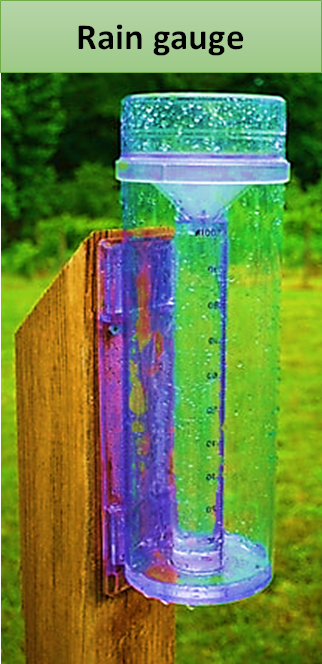
Which of the following instruments is used to measure rainfall?
(a)Barometer
(b)Thermometer
(c)Rain Gauge
(d)All of the above
Answer
506.5k+ views
Hint: This is the most basic hydrological instrument which is first discovered by the Christopher Wren It is generally used by meteorologists and hydrologists. The hydrologists measure the amount of liquid precipitation over a certain period of time.
Complete answer:
The rain gauge is an instrument that is used for measuring rainfall. The rain gauge is also known as an udometer, pluviometer, or an ombrometer. It measures the rain in a localized area. To measure the rain, rain gauges should be placed in an outer area where there are no obstacles like buildings or trees or other things to block the rain. There are different types of rain gauges that include graduated cylinders, weighing bucket gauges, tipping bucket gauges, and simply buried pit collectors.
Weighing Bucket Gauge: It is a self-recording type of rain gauge. It contains a receiver bucket which is supported by a spring or some other weighing mechanism. Due to its increased weight, the movement of buckets transmitted to a pen which traces records on a clock-driven chart. It gives a plot between the accumulated rainfall values and the elapsed time.
Tipping Bucket Gauge: It includes a pair of buckets that are pivoted under the funnel in such a manner, when one bucket receives rainfall its tips discharging rainfall into the container, carrying the other bucket under the funnel. This rain gauge is not as accurate as of the standard rain gauge
-A barometer is an instrument that is mainly used to measure atmospheric pressure.
-A thermometer is a device that measures the temperature or temperature gradient.
-A hygrometer is a device that is used to measure humidity.
So, the correct answer is ‘Rain Gauge’.
Note: -The main drawback of this Rain Gauge is that it cannot measure the rain in tropical cyclones due to wind extremes.
-Raingauge determines the depth of precipitation in millimeters.

Complete answer:
The rain gauge is an instrument that is used for measuring rainfall. The rain gauge is also known as an udometer, pluviometer, or an ombrometer. It measures the rain in a localized area. To measure the rain, rain gauges should be placed in an outer area where there are no obstacles like buildings or trees or other things to block the rain. There are different types of rain gauges that include graduated cylinders, weighing bucket gauges, tipping bucket gauges, and simply buried pit collectors.
Weighing Bucket Gauge: It is a self-recording type of rain gauge. It contains a receiver bucket which is supported by a spring or some other weighing mechanism. Due to its increased weight, the movement of buckets transmitted to a pen which traces records on a clock-driven chart. It gives a plot between the accumulated rainfall values and the elapsed time.
Tipping Bucket Gauge: It includes a pair of buckets that are pivoted under the funnel in such a manner, when one bucket receives rainfall its tips discharging rainfall into the container, carrying the other bucket under the funnel. This rain gauge is not as accurate as of the standard rain gauge
-A barometer is an instrument that is mainly used to measure atmospheric pressure.
-A thermometer is a device that measures the temperature or temperature gradient.
-A hygrometer is a device that is used to measure humidity.
So, the correct answer is ‘Rain Gauge’.
Note: -The main drawback of this Rain Gauge is that it cannot measure the rain in tropical cyclones due to wind extremes.
-Raingauge determines the depth of precipitation in millimeters.

Recently Updated Pages
Master Class 12 Business Studies: Engaging Questions & Answers for Success

Master Class 12 Economics: Engaging Questions & Answers for Success

Master Class 12 English: Engaging Questions & Answers for Success

Master Class 12 Maths: Engaging Questions & Answers for Success

Master Class 12 Social Science: Engaging Questions & Answers for Success

Master Class 12 Chemistry: Engaging Questions & Answers for Success

Trending doubts
Full Form of IASDMIPSIFSIRSPOLICE class 7 social science CBSE

Convert 200 Million dollars in rupees class 7 maths CBSE

One lakh eight thousand how can we write it in num class 7 maths CBSE

What are the controls affecting the climate of Ind class 7 social science CBSE

List of coprime numbers from 1 to 100 class 7 maths CBSE

Write a letter to the editor of the national daily class 7 english CBSE





